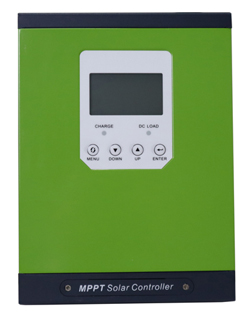The solar charge controller is a device used to control the solar panel to charge the battery and at the same time give the load control voltage to the voltage-sensitive device. The solar charge controller regulates and controls the charging and discharging conditions of the battery, and controls the power output of the solar cell components and the battery to the load according to the power requirements of the load. It is the main control part of the entire solar power supply system and plays a crucial role in a solar power system. The following are the primary functions of a solar charge controller.
What are the functions of solar charge controllers?
 Load overcurrent and short-circuit protection: After the load current exceeds 10A or the load is short-circuited, the fuse is blown and can be used after replacement.
Load overcurrent and short-circuit protection: After the load current exceeds 10A or the load is short-circuited, the fuse is blown and can be used after replacement.- Overvoltage protection: When the voltage is too high, the output is automatically turned off to protect the device from damage.
- Lightning protection: In the event of a lightning strike, the varistor can prevent lightning strikes and protect the solar charge controller from damage.
- Reverse battery connection protection: The battery "+" and "-" polarity is reversed, and it can continue to be used after correction.
- Battery open circuit protection: If the battery is open circuit, if the solar battery is charged normally, the controller will limit the voltage across the load to ensure that the load is not damaged. If at night or when the solar battery is not charged, the controller itself cannot electricity and there will be no movement.
- Overcharge protection: When the charging voltage is higher than the protection voltage, the battery is automatically disconnected to charge the battery. After that, when the voltage drops to the holding voltage, the battery enters the floating charge state. When the recovery voltage is lower than the floating charge, the floating charge is turned off and enters the equalizing charge state.
- Over-discharge protection: When the battery voltage is lower than the over-protection voltage, the controller automatically turns off the output to protect the battery from damage; after the battery is recharged, it can automatically restore the power supply.
- Self-checking function: When the controller is affected by natural factors or improper personal operation, the controller can be self-checked to let the user know whether the controller is normal and reduce unnecessary man-hours.
- Recovery interval: The recovery interval of the controller's overcharge or over-discharge protection to prevent the load from jittering due to the line resistance or the self-recovery characteristics of the battery.
- Temperature compensation: Charge controllers with temperature sensors can adjust the charge rate based on the temperature of the battery, which monitors the temperature of the battery, corrects the charge and discharge values, and makes the battery work in an ideal state. This function is critical in environments with extreme temperatures, as it helps maintain the battery’s efficiency and longevity.
- Light control: Most solar charge controllers are used in automatic lamps. When the environment is bright enough, the controller will automatically turn off the load output; and when the surrounding environment is dark, it will automatically turn on the load to realize the automatic control function.
- Monitoring and display: Advanced charge controllers come with monitoring and display features that provide information on the system’s status, such as battery voltage, charging current, and state of charge. This helps manage and maintain the solar power system more effectively.
- Equalization: Some charge controllers offer an equalization function that periodically overcharges the battery slightly to balance the charge across all cells. This can help maintain battery health and performance, especially in lead-acid batteries.
- Monitoring system performance: It can provide information about the system's performance, including voltage, current, and battery status, which can be displayed on an LCD or monitored remotely.
- Fault protection: It helps protect the system from faults such as short circuits, over-current, and reverse polarity, enhancing the safety and reliability of the system.
Overall, a solar charge controller ensures efficient energy management and protection of the solar power system, extending the life of the batteries and optimizing the performance of the solar panels.
